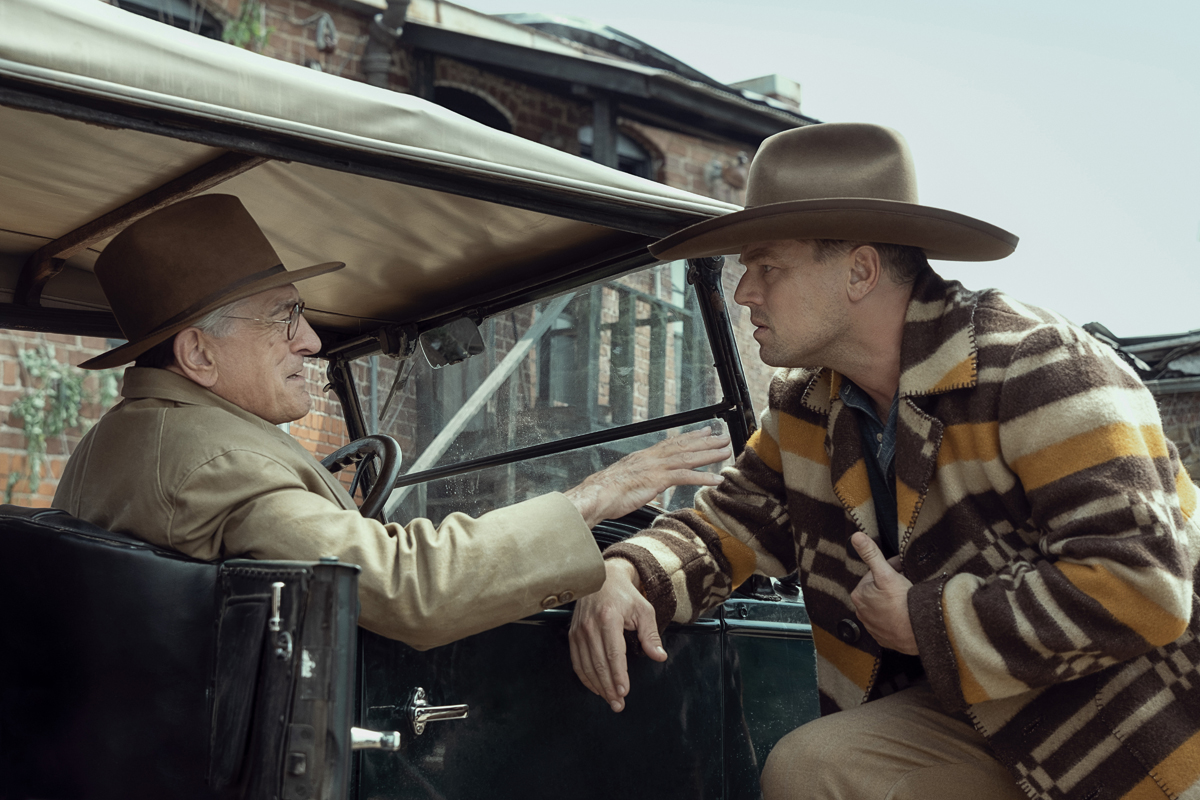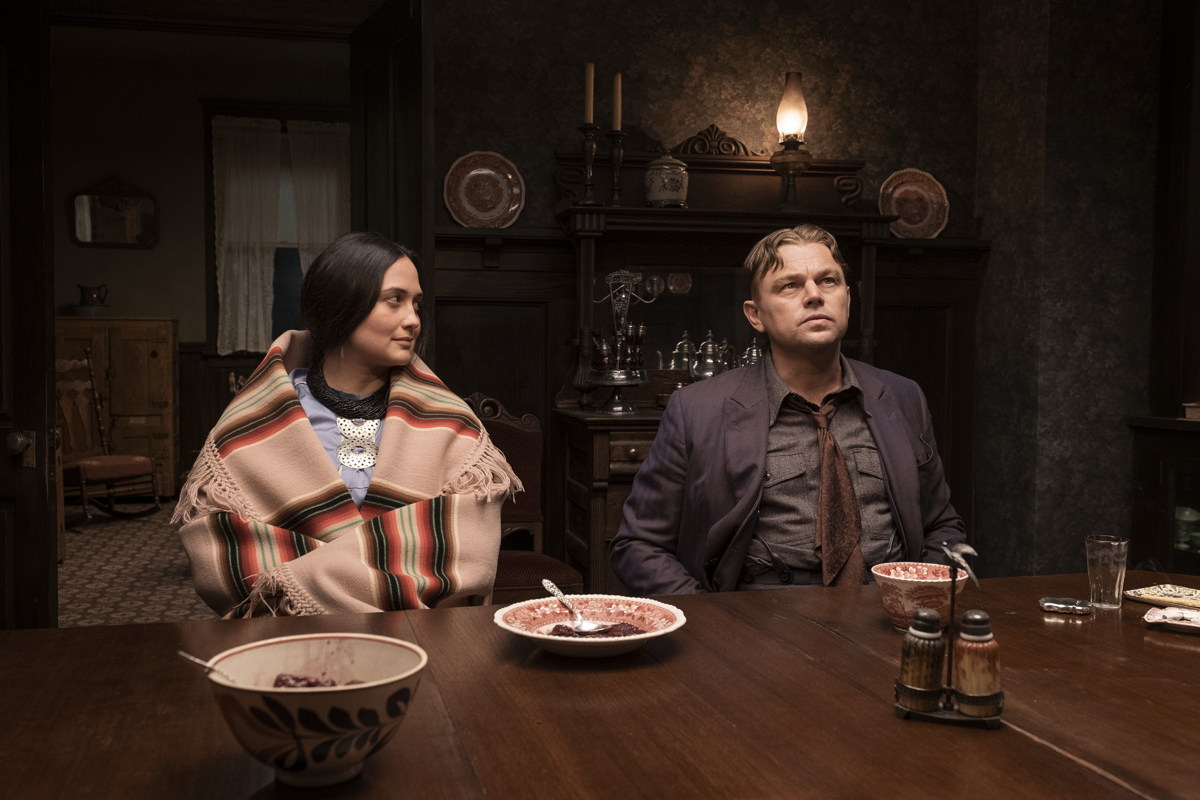 Nick Pinkerton
Nick Pinkerton
Scorsese’s film about the murders of Osage Native Americans in the 1920s defies conventional storytelling expectations in favor of
moviegoing as witness-bearing.

Leonardo DiCaprio as Ernest Burkhart and Lily Gladstone as Mollie Burkhart in Killers of the Flower Moon. Courtesy Apple TV+.
Killers of the Flower Moon, directed by Martin Scorsese,
now playing in theaters
• • •
Martin Scorsese’s Killers of the Flower Moon is a film gnarled up in paradox, not least of these that it’s both a fascinating and a deeply confounding work. It enthralls precisely because it withholds the easy gratifications and familiar reassurances one expects at the multiplex; it’s a $200 million behemoth that rejects or subverts traditional ideas of character identification, dramatic tension, and catharsis, paced in such a manner as to approximate the effects of a lingering, morbid, ever-worsening illness.
A years-in-the-making, three-and-a-half-hour epic, Scorsese’s film, which he cowrote with Eric Roth, is based on the 2017 nonfiction book of the same title by journalist David Grann. Killers of the Flower Moon is set in oil-rich Osage County, Oklahoma, and dramatizes a series of murders that occurred there from 1921 to 1926, orchestrated by political boss and rancher William King Hale, played in the movie by Robert De Niro. Hale, with a ring of coconspirators and cronies, set out to separate the Osage from their black-gold money through a variety of cutthroat schemes that included calculated intermarriage with Osage women, whose headrights to communally held oil wealth would come into white hands once they were conveniently disposed of.

Robert De Niro as William King Hale and Leonardo DiCaprio as Ernest Burkhart in Killers of the Flower Moon. Courtesy Apple TV+.
After an ecstatic overture that depicts the discovery of oil on the tribal reservation and, via newsreel re-creations, the orgy of conspicuous consumption that came with new fortune, the movie settles in to describe the long hangover that follows the brief intoxication of unaccustomed luxury. We enter Osage country alongside one of the arriving white interlopers lured by the scent of money: Hale’s nephew, Ernest Burkhart (Leonardo DiCaprio). A man of limited wit and no apparent ambitions outside easy living, Burkhart is only too happy to put himself in a position of vassalage to Hale, a character that De Niro invests with an air of glad-handing good-ol’-boy despotism to recall Walter Huston’s performance as the patriarchal cattleman in Anthony Mann’s Western tragedy The Furies (1950). So when Hale encourages his nephew to take a moneyed Osage woman, Mollie (Lily Gladstone), as his wife, he offers no protest—in fact, Burkhart seems truly infatuated with her. As to whether he fully understands that he’s being appointed as her executioner when they take their vows is but one of the film’s many unresolved ambiguities.

JaNae Collins as Reta, Lily Gladstone as Mollie Burkhart, Cara Jade Myers as Anna, and Jillian Dion as Minnie in Killers of the Flower Moon. Courtesy Apple TV+.
The precise details of Hale’s master plan fall into place only gradually, though Killers of the Flower Moon isn’t a proper murder mystery: the culprits are hiding in plain sight and can continue acting with impunity only because it takes an awfully long time to interest the United States federal government in the suspicious deaths of scores of Native Americans. Our backstage views of the Osage intrigues at first come through the blinkered perspective of Burkhart, conceived of here as a supporting actor content to walk through his scenes in the bloody drama his uncle has penned without trying or wanting to understand their significance to the larger script, the latest in a long lineage of Scorsese’s passive protagonists. (From Harvey Keitel’s Charlie Cappa in 1973’s Mean Streets to De Niro’s Frank Sheeran in 2019’s The Irishman, Scorsese’s filmography is rife with men who find it easier to follow orders than their consciences, and Killers of the Flower Moon is something like Bernardo Bertolucci’s 1970 The Conformist cut in the American grain.) At times the film feels like a detective story turned inside-out, one in which the detective also happens to be one of the criminals. It will remain for agents from the Bureau of Investigation—forerunner of the modern FBI—to descend on Osage, fill in the occlusions in the plot, and put Hale and Burkhart before the judge.

Robert De Niro as William King Hale and Jesse Plemons as Tom White in Killers of the Flower Moon. Courtesy Apple TV+.
On Burkhart’s arrival in his new home, his uncle advises him against running his mouth around the Osage, who have a phrase to describe the white man’s glib chatter: “blackbird talk.” Killers of the Flower Moon is a film noisy with the chirp of empty words and promises, observing the vast distances between how its characters present themselves in speech and reveal themselves in action, the almost infinite capacity of human beings for self-deception and self-justification, and the fact that history is shaped and lives are routinely destroyed by villains who are tranquilly certain of their own virtue. When Hale calls the Osage “the finest and most beautiful people in the world,” he does so with a throb of heartfelt emotion in his voice.
Unlike the menfolk, Mollie is measured and considered in her speech, and communicates as much with her eyes as with her tongue. Gladstone’s steady, level, open gaze variously conveys longing, suspicion, and outrage, but whatever else it happens to be saying, that gaze articulates it with an undercurrent of mournful compassion—words that could also describe the perspective that Scorsese applies to his characters. (There is little of the intoxicating subjective complicity of the director’s earlier crime pictures here, and the viewer is repeatedly put in the position of mute, helpless witness to atrocity.)

Lily Gladstone as Mollie Burkhart and Leonardo DiCaprio as Ernest Burkhart in Killers of the Flower Moon. Courtesy Apple TV+.
The triangle between Burkhart, his wife, and his uncle forms the dramatic core of Killers of the Flower Moon, but a good portion of the film’s runtime is given over to digressive passages showing both the operations of the Hale gang’s various tentacles and the response to the murders in the Osage community. There are at least a dozen other sharply rendered characters that pop out of the film’s vast, teeming canvas, including Everett Waller as an Osage elder whose emotional tribal-council oratory is an aria of moral indignity in the musical cadence of Native American English, and wiry, grandly mustached cowboy-actor Ty Mitchell as a saddle tramp used by the Hale syndicate as a triggerman, as evidently contemptuous of his employers as he is toward himself for his dependence on them. With such indelible, life-marred faces as these—as well as the scrupulous work of production designer Jack Fisk, who shows us a West with one foot in the Jazz Age—Scorsese’s film reproduces a century-old American scene in such simultaneous expanse and detail as to make it feel as close as yesterday.
This exquisite artifice is undone in Killers of the Flower Moon’s coda, a blindsiding narrative rupture that occurs just as Hale is set to go on trial, in which the events of the hearing and its aftermath are reenacted on a true-crime radio program being recorded at some unspecified point in the future, when Hale and the Burkharts are in their graves. This coup de cinéma ending both acts as a pointed commentary on the tradition of repackaging real-life tragedy as entertainment and, in taking the place of a traditional courtroom climax, removes any sense of gavel-banging resolution such a scene might have lent the film. Instead, Killers of the Flower Moon concludes on a note of eulogistic sorrow—a direct authorial comment on a death that’s closer to Dickens’s “Dead, my lords and gentlemen” plaint in Bleak House than anything I know in cinema. A sentence has been handed down, but the case will never be closed.
Nick Pinkerton is the author of the book Goodbye, Dragon Inn, available from Fireflies Press as part of its Decadent Editions series. His writing on cinematic esoterica can be found at nickpinkerton.substack.com, among other venues. The Sweet East, a film from his original screenplay directed by Sean Price Williams, premiered in the Quinzaine des Cinéastes section of the 2023 Cannes Film Festival.